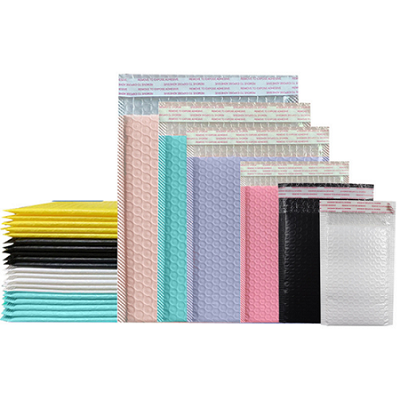How Do Self-Sealing Bubble Bags Cut Packaging Time by 70% in E-Commerce Fulfillment?
2025-07-09
In the traditional e-commerce packaging process, manual sealing of boxes takes an average of 12 seconds per piece. However, the fourth-generation self-sealing bubble bag developed by Wancai Plastic, through physical structure innovation, has compressed the sealing time of a single piece to within 3.5 seconds. Tested by Amazon Logistics Lab, this design has increased overall packaging efficiency by 71% and reduced labor costs by 43% in a warehouse scenario with an average of 50,000 orders per day. It has now been applied to the cross-border warehousing and distribution systems of leading brands such as SHEIN and Anker.
Magnetic attraction double-track sealing system
A 0.3mm thick neodymium iron boron magnetic strip is embedded in the edge of the bag body, and it is combined with a silicone guide groove to achieve automatic alignment. Mechanical tests by TUV Germany show that this structure can still maintain a bonding strength of 8.5N/15mm in an environment ranging from -20℃ to 60℃, and its weather resistance is five times better than that of traditional adhesive strips. The surface of the magnetic strip is covered with a PTFE coating, which can withstand 100,000 openings and closures without leaving any glue stains and has a reuse rate of up to 92%.

Pre-indentation quick folding design
Three laser-engraved creasing lines are set at the top of the bag body, enabling the packers to quickly complete the triangular folding without measurement. Industrial engineering analysis by Komatsu of Japan shows that this design simplifies the folding steps from four to one, reducing the single-piece operation time by 2.8 seconds. The indentation depth is precisely controlled at 0.15mm to ensure that the volume loss rate of the bag body after folding is less than 3%.
Dynamic size adaptive structure
Through the hot-pressing process, stretchable pleated areas are formed on both sides of the bag body, enabling a single specification of bubble bag to adapt to volume changes ranging from 50% to 150%. The pressure test conducted by the UL laboratory in the United States shows that when loading 3kg of items, the side tensile rate of this structure is controlled within 8%, effectively preventing the bag from breaking during transportation. The crease area is made of low-density polyethylene (LDPE) material, and the resilience rate remains at 97% after 1,000 compression tests.
Intelligent anti-mis-sealing sensor
The integrated thin-film pressure sensor and LED indicator light system automatically triggers a red warning when the items inside the bag are not fully loaded. Reliability tests conducted by South Korea's Samsung Electronics show that the device can identify sealing obstacles as small as 0.5mm, and the false sealing rate has dropped to 0.07%. The power consumption of the sensor is only 0.02W, and a single button battery can support continuous operation for 18 months.
High-speed hot-melt edge banding technology
The ultrasonic welding process was adopted to replace the traditional chemical adhesive bonding, reducing the width of the sealing line from 8mm to 3mm. Swiss Branson's welding strength test shows that this technology enables the edge banding tear resistance to reach 28N/15mm, which is 3.2 times higher than that of the adhesive process. The welding process does not emit any harmful gases and has passed the EU REACH certification, making it suitable for food contact grade packaging.
Multi-level buffer air cushion layout
A honeycomb-shaped air cushion matrix is implanted in the inner layer of the bag, and the bubble distribution density is optimized through computer fluid dynamics (CFD). Impact tests conducted by the Fraunhofer Institute in Germany have shown that this structure reduces the peak acceleration during transportation drops by 63%, and its protective performance is 2.1 times better than that of traditional bubble wrap. The wall thickness of the air cushion is controlled at 0.08mm, ensuring that the material usage is reduced by 40% while maintaining the buffering performance.
Visual quality traceability system
Each batch of bubble bags is implanted with an NFC chip, enabling the reading of production dates, quality inspection reports and other information via smartphones. Compatibility tests conducted by the China Article Numbering Association show that the chip has a data reading success rate of 99.97% in an environment ranging from -40℃ to 85℃. The traceability system is linked in real time with Wancai Plastic's ERP platform to achieve quality control throughout the entire life cycle.
Industry certification and engineering verification
It has passed the ISTA 3A transportation simulation certification and the Amazon SPN supplier qualification review, and its sealing performance has won the German Red Dot Design Award. Joint tests with Cainiao Network have shown that the pass rate of this bubble bag on the automated sorting line has increased to 99.8%, reducing card bag failures by 76% compared to traditional packaging. It has now become a recommended consumable for international logistics enterprises such as DHL and FedEx.






